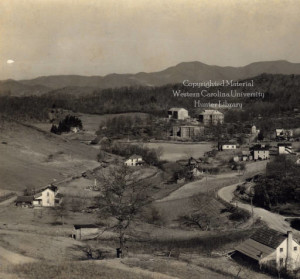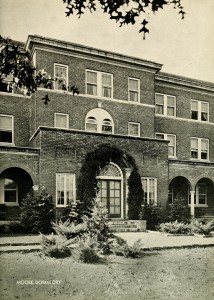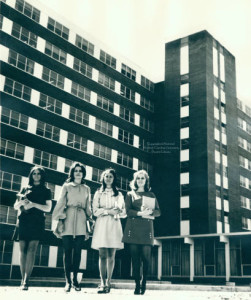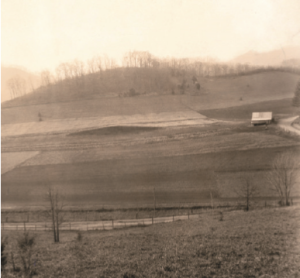You can hear some pretty interesting conversations riding the campus CatTran when you pay attention.

Old photo of campus could date back to as early as 1920s. Photo courtesy of Special Collections, Hunter Library, WCU.
I got on a CatTran full of about 20 of my fellow students around midnight to head back to my dorm after work. As we ascended the hill into old campus, the dark, spooky and abandoned Moore Building loomed over Joyner Drive and it inspired a discussion of a couple common campus ghost stories.
“I heard that Moore was haunted,” a woman on the CatTran said abruptly. “Some girl’s lover died during World War II and she committed suicide during her depression.”
“That’s not true,” argued a man sitting in the front. “A girl was murdered in Moore and her spirit haunts the third floor. People refused to live there when it was a dorm because you could hear her crying.”
“You know Scott’s haunted,” said another man. “I had a friend who lived on the eighth floor her freshman year and she said she could hear footsteps going down the hall at all hours of the night, but when she opened the door, no one was there.”
“It’s an old campus,” concluded the CatTran driver. “At 127 years old, some crazy things are bound to have happened here.”
The driver was right. Western Carolina University has accumulated many ghost stories over the years that stimulate student gossip, especially around Halloween.
The conversation sparked my curiosity. As a fourth year senior, I had heard about every ghost story the campus’ students have to tell. But I didn’t know any details, just vague events that may or may not have any truth behind them.
The next day, I went to the library and searched through newspaper archives from The Western Carolinian and The Cullowhee Yodel, a former campus newspaper, to see what I could find about potential haunted locations or suspicious deaths on campus.

Moore Dormitory in 1933. Photo courtesy of WCU digital yearbook collection.
Most of the information I found was about Moore Building. It wasn’t surprising that it was such a popular topic as the oldest, and arguably most well-known, haunted location on campus.
There are several stories about what actually happened in Moore to give it the haunted reputation. The most common story, from the 1960s involves a girl who was enrolled in the teaching program. She was murdered by a local resident when she didn’t return his romantic interests. Although the man was caught, the story is, his family connections allowed him to serve a few years at Broughton Hospital in Morganton instead of going to jail.
After the girl’s death, residents on the third floor of Moore reported sounds of crying, screaming and pacing. Many students also claimed they felt like they were being watched. The haunting supposedly stopped in 1997 when the man who murdered the girl died.
Although the building is now closed, it has served many purposes over the years. It opened in 1924 as a dormitory for 180 women in the location of former Cullowhee Normal and Industrial School. Moore Dormitory was named for Judge Walter E. Moore of Hayesville, a former state senator who funded the construction of the building.
In 1931, a portion of the building was turned into a cafeteria. The cafeteria was moved to the Brown Building in 1957. The basement of Moore was used as the campus Infirmary until Graham was built in 1939. The basement also functioned as a morgue. The building was converted to classrooms in the late 1980s for Health and Human Sciences until the new HHS building opened in 2012.

Scott Hall shortly after its construction in the early 1970s. Photo courtesy of Special Collections, Hunter Library, WCU.
After the building was converted into classroom space during the 1980s, the third floor was boarded up and left unused.
Scott Hall is another campus location known for its ghost stories. The eighth floor of the building is said to be haunted by a girl who hung herself in the east wing during the 1990s.
Newspaper archives I found allege that the floor was closed to residents for many years after students reported seeing the young woman’s ghost.
When I lived on the supposedly haunted floor as a freshman, I didn’t pay much attention to the ghostly rumors – until I witnessed it for myself.
I remember the incident vividly, despite how tired I was at the time. I was taking a shower at 3 a.m. on a Wednesday after staying up to study for an exam. Facing the shower curtain, I opened my eyes and watched a perfect silhouette of a person walk by the entrance to my shower stall. Normally, this wouldn’t have fazed me, but most sane students were asleep at this hour and the bathroom doors were so heavy that it made it impossible to open or close them quietly. I hadn’t heard anything.

Former Cherokee ancestral mound before it was leveled to make room for Killian Building. Photo courtesy of WCU historic walking tour.
I immediately went over to the curtain to peek my head out and see who it was, only to find the room empty. No one had entered or exited, and yet I couldn’t bring myself to write off what I had seen.
Despite this spooky incident, and the occasional feeling of being watched, I never felt unsafe or wary while living there. Other students have reported bathroom lights turning on and off and doors opening and closing at random.
Scott opened in 1969 and currently houses about 700 freshman students as the largest co-ed community on campus.
Killian Building opened in 1966, and it may not have a past homicide or suicide, but the history of the land spells “bad juju” for many campus residents. A Cherokee village and ancestral mound once stood on the land. That history was bulldozed in 1956 to clear the site for Killian’s construction. The university decided to level the mound, because it was thought to have been examined by researchers in the 1880s, according to documents from WCU’s Office of Public Relations.
These mounds were sometimes constructed by the Cherokee as platforms for council houses, and although the mound on WCU’s campus is not thought to have been a “burial mound,” Cherokee leaders were often buried in floors of council houses.
So, is WCU’s campus really haunted? Or is it all just a hoax that we use to scare freshman and make the Halloween season more exciting? With no definitive proof of any suicide or murder on campus, it’s up for the students to decide.



